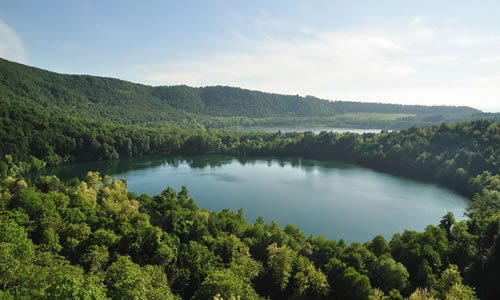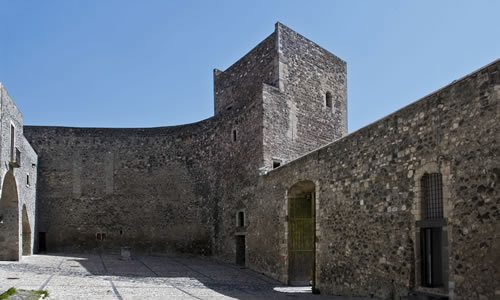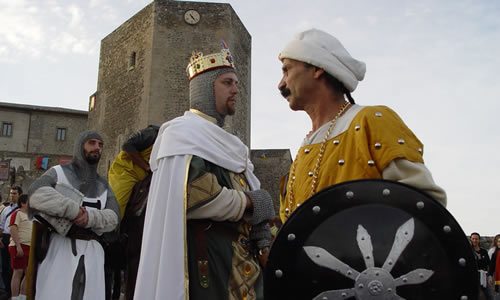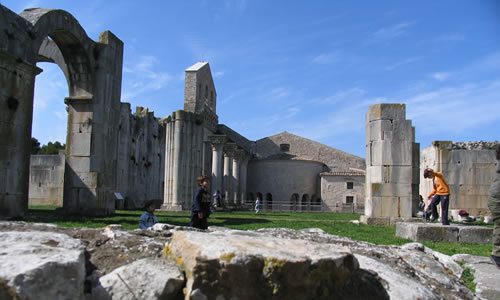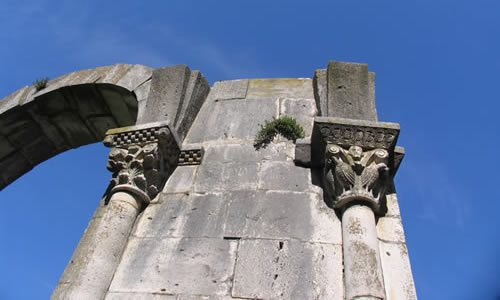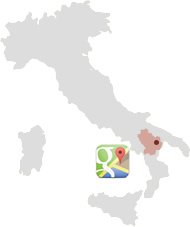The Vulture Alto Bradano is the area situated in the north east of Basilicata, nestled among the regions of Puglia and Campania and the province of Potenza. Dominated by Mount Vulture, the surrounding land is characterised by a succession of hilly slopes, covered with chestnut and oak trees, and high plains with olive groves, vineyards and Mediterranean shrub.
The Monticchio Lakes, Castel Lagopesole, and the historic town centres of Melfi and Venosa are among the most important tourist attractions of this area.
It is a territory renowned for its natural beauty and scenery, for the quality of the wine, especially the Aglianico del Vulture, and for many other typical products such as the Marroncino di Melfi (a type of Chestnut), the Pecorino di Filiano (a sheep’s milk cheese) and organic olive oil.
Vulture |
The Monticchio Lakes
At the bottom of the Mount Vulture slopes, there is a large crater that is today filled in by the Monticchio Lakes. The two still water lakes, rich in mineral salts, are divided by a narrow stretch of land on which we can find the ruins of the Abbey of St. Hippolytus. The lakes are the only place in the whole of the Southern Italy where the Nymphaea alba, also known as the European white water-lily, takes root and grows spontaneously. Its large floating leaves are anchored to the lake’s bed by long stems that can reach between 4-5 metres in length and that rise to the surface in springtime.The local wildlife is made up mainly of hares, squirrels, foxes, badgers and weasels on the ground and buzzards, red kites and kestrels in the air. The Lakes are the only place in Europe where we can admire the European Owl Moth, a nocturnal moth belonging to an oriental species, that was first discovered in Grotticelle di Monticchio, in the Atella area.
A preservation area has been set up to protect the species that can be seen only for a short time in spring yet spends about 9 months in a chrysalis stage hidden among the moss and dead leaves.
Melfi
Melfi is built on a hill facing onto the Ofanto Valley not very far from Mount Vulture. The historic centre is enclosed within the original Norman city walls that were rebuilt during the Aragonese Age. The castle is polygonal in shape, boasting eight towers and a defensive moat, and is the result of a series of events that took place over the centuries.The oldest nucleus is composed of a central building with four corner towers that enclose a main square area that was purposely built by Norman horsemen at the beginning of the 12th century. Five Papal Councils have been held in this Castle and the first Crusade to the Holy Land was proclaimed within these walls in 1089. The castle was extended the following century, at the request of Federico II, and became the Kingdom’s treasury, prison and an important study centre where Pier delle Vigne and Riccardo da Capua drew up the Costitutiones Augustales, the oldest written text of medieval law, an extremely important work in the history of written law.
Venosa
Venosa è un comune in provincia di Potenza riconosciuto tra i Borghi più belli d’Italia.Le origini di Venosa si perdono nella notte dei tempi. Il sito preistorico di Notarchirico, posto a pochi chilometri dal centro abitato, è il più antico della Basilicata. Ha restituito numerosi resti fossili di animali estinti, il femore dell’homo erectus e numerosi strumenti litici. La città fu fondata dai romani nell’anno 291 a.C. a controllo della valle dell’Ofanto, e della via Appia. I Romani dopo la vittoria sui Sanniti, dedicarono la città a Venere, divinità cara ai vinti.
La storia di questa città a partire da questa data è legata alla storia di Roma che la eleva a Municipium (città romana), estendendo il diritto di voto e di cittadinanza ai suoi abitanti. Qui nacque e trascorse la sua adolescenza il grande poeta latino Quinto Orazio Flacco. Sono presenti numerosi siti di interesse storico e in particolare da non perdere la visita al Parco Archeologico di Venosa.


 Home
Home

